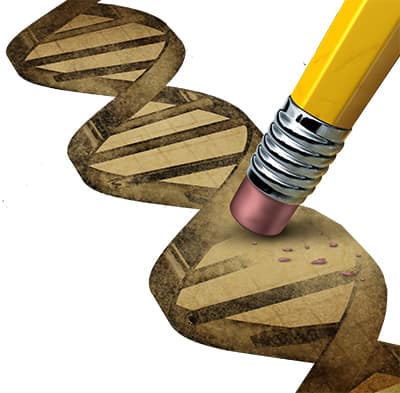CRISPR Gene Editing Technology
The Human Advancement
 Human often marvels at the things they create. From large structure to technologically mind-blowing machines, many impressive achievements warrant awe and amazement. A close look at these things will reveal their workings and both their strengths and their flaws. However, surrounded by all of this, one may forget from time to time to look, not only atones surroundings but also at one’s self. Humans are vastly complex beings; perhaps more complicated than anything we will ever create. And yet for our entire history, we have concentrated on advancing the world around us while never genuinely having advanced ourselves.
Human often marvels at the things they create. From large structure to technologically mind-blowing machines, many impressive achievements warrant awe and amazement. A close look at these things will reveal their workings and both their strengths and their flaws. However, surrounded by all of this, one may forget from time to time to look, not only atones surroundings but also at one’s self. Humans are vastly complex beings; perhaps more complicated than anything we will ever create. And yet for our entire history, we have concentrated on advancing the world around us while never genuinely having advanced ourselves.
One of the latest things we will hear about in the news and from the top scientific professionals is the matter of gene editing technology, most notably CRISPR (Clustered Regularly Interspaced Short Palindromic Repeats). To be more specific to human use, CRISPR-Cas9, as before it was ever considered to use on humans, it was used to alter the genetics of other organisms. This scientific technique, which came into existence in around 2012, allows for the editing of the very genetic structure of an individual. The implications are massive, though the topic is quite decisive. Gene editing is something even scientist are still learning about, and the idea and practice are very much in its infancy.
One of the most significant areas of the whole practice is the idea and viability of using the CRISPR to edit the genes of embryos. Modifying the genes of embryos will allow for potential genetic mutations and genetic diseases to be removed from the child’s genome before birth and could save a child from having to live with a potentially harmful or detrimental trait. The achievement can be by removing the specific set of coding in the embryos DNA that would be mutated and would cause the negative character, and to then use the CRISPR technology to implant the new genetic structure. It may sound all positive, though there are many implications and ethical dilemmas to consider.
The UK at the Forefront
The UK is making quite some progress in the matter of gene editing. They can see the potential benefits of the process when done correctly and are looking to move their knowledge of the topic forward. Around the start of 2016, UK scientists were given the go-ahead to begin testing and using CRISPR on human embryos for research purposes. It was approved of by the UK Human Fertilisation and Embryo Authority (HFEA) and was the first time something like this received approval outside China.
One thing to note is that this is not the first type of human genetic editing that has occurred. There have previously been gene therapies available, but not in the same way that CRISPR looks to move things forward. Prior, there was the possibility to have the genetics of somatic cells within an adult human edited for medical purposes. This form of editing was managed in the UK by the Human Tissue Authority (HTA), which received acknowledgment under the Human Tissue act of 2004. Now, this is a little divergent from the CRISPER concept, though it does show how the UK has been highly progressive in the matter of human genetic engineering. Having been established in 2004, this occurred around 11 years before the first human trials of CRISPER, and may very well have paved the way for the UK’s future as a world leader in the area of early gene editing technology.
The hope is that the technology will, in time, be used for the curing of diseases and disabilities in embryos before they are born. The technology works by editing the DNA structure of the cells of an organism, by cutting away unwanted segments and adding in preferred portions. The research for the moment is concerned with fighting diseases that we have, up to this point, had no answer, and is mainly interested in the most negatively impacting diseases that there are. Since the science is not yet fully understood, it would more often than not, be seen as too high a risk to take for less problematic issues, though for the time, the research is being performed on spare IVF embryos usually only a few cells in size.
It is because gene editing is still looked upon skeptically by quite a few due to what it could lead to as it advances. There are ethical issues concerning the topic. The biggest of these seems to be the fear some have that there may come a time when designer babies become a thing. It will allow for certain individuals to pay to have their children’s genetics altered to have favorable traits, including the appearance of the individual, and though we have an insufficient understanding of it at the moment, we may be able even genetically to modify individuals for higher intelligence and certain personality traits. It is very much a distant prospect, as we are still in the early stages of using the technology for simple and vital issues, though with the research into the issue growing, we will inevitably start to look into controversial areas such as these when they become a more comfortable thing to achieve.
The Chinese have been attempting to use gene editing technology since around 2015, as far as we know, and have used the technique on approximately 86 or more people. Matters such as these in China are not as well known about regarding the details and results of tests. Further to this, the regulations regarding the issue are also different from much of the rest of the world, and so the Chinese may be more open to and freer regarding the matter and the research they perform. With this considered, it was in this year that a group of scientists did what no other individual or organization had done before. The concept had been extensively tested and was watertight. The biggest issue in testing for humans is that we are generally more complicated than the test analogs that we use. However, the Chinese researchers went ahead and performed the test as per their precise calculations on the previously mentioned 86 non-viable zygotes. In the end, the test was in many ways a failure though. Only 26 of the zygotes had their genomes successfully cleaved, and from a scientific standpoint, that is not a success rate. However, and more importantly, the research was underway
 Outside of China though, the UK is at the forefront. The first law regarding the issue of genetic manipulation was the Genetic Manipulation Regulations of 1989. However, this law does not extend to humans. Preferably it is more concerned with the genetic manipulation of animals for the research purposes, which is something that has been allowed by the law for quite some time now, though it was not at that time see that it would be an issue for a human. The next big step in the UK was the limited go-ahead to certain scientific organizations to begin using and researching the practice in 2016
Outside of China though, the UK is at the forefront. The first law regarding the issue of genetic manipulation was the Genetic Manipulation Regulations of 1989. However, this law does not extend to humans. Preferably it is more concerned with the genetic manipulation of animals for the research purposes, which is something that has been allowed by the law for quite some time now, though it was not at that time see that it would be an issue for a human. The next big step in the UK was the limited go-ahead to certain scientific organizations to begin using and researching the practice in 2016
Regarding the human side of things, all matters to do with embryology are under the governance of the Human Fertilisation and Embryology Authority (HFEA). The HFEA has been given its powers through the Human Fertilisation and Embryos Act of 2008, though this was before the rise of CRISPR. As Crisper has come around, the HFEA has come up with their guidelines for researchers to abide. While the HFEA is most prominently known to cover the issues of fertility treatment etc. they now also deal with related matters including CRISPR.
Now while some scientists have been given the go-ahead by the HFEA to perform research using gene editing technologies, this by no stretch means that it is legal on a larger scale. The individuals allowed to conduct this research are insufficient in number, and since the HFEA is the only body in the UK that is permitted to provide the license required to do this research. Individuals should submit an application to them on the matter, and their issuing of the permit would be insufficient and strict, though not impossible. As recently as early as 2018, grants are issued in small numbers of new individuals and organizations.
The reason for the severe limitations to the number of groups that can use CRISPR to do research is because the issue is one that can be seen to be quite sensitive. There are many ethical dilemmas one must consider and not all will agree on the matters raised.
It is apparent that the HFEA has a policy that no gene editing research may take place without first obtaining research ethics approval, even by the approved bodies. What this means is that to perform analysis in genetic engineering for humans, one would first have to be approved of by the HFEA to be eligible to do this type of research, and then for every potential project of research they would look to perform, they would have to receive a further approval.
It ensures two things. Firstly, the research that scientists are doing is known to the regulatory bodies, and they are aware and up to date on what the licensed parties wish to do. Parties will get information about the research, and then the authorized bodies must wait until these proposals are accepted. Secondly, it allows people other than scientists to look into the issues that are for research and the methods that are being used to perform the investigation, and it provides for them to discuss them from an ethical standpoint. Once in-depth consideration is on the matter from multiple parties, it can then commence. As seen here, this is a highly regulated area, as it rightly should be, and it ensures we do not move forward into areas that can be dangerous.
Where is the Rest of the World?
While the UK is one of the countries at the forefront of gene editing research; other countries are also becoming more open to the prospect. While there are no laws that govern this field, too, there are generally no countries which allow for genetic engineering. It is often a banned practice except, as previously mentioned, for certain entities that have received the necessary approvals.
Considering the US, they were first given a yellow light (much like the UK, only the approved and licensed bodies may research into the field) to perform research in the area of human genetic engineering towards the beginning of 2017. They showed their first CRISPR genetic engineering to embryos towards the latter stages of 2017. With the case of the US, this allowance was only for research at first, with no editing to perform viable embryos that would go on to later be born, and substantial research would be required before this technology would become available to a further degree.
The issue was a scorching one during the year of 2016, with many on both sides of the table. Some were calling for a complete ban on the editing of human genetics in embryos, as they saw it leading to unethical practices and other who saw it as unnatural. In general within the country though, the method is still illegal, as none may perform practical research on the matter, and the only bodies that are allowed to, are highly official and highly regulated bodies. It would be near impossible for smaller organizations to obtain the license.
The US’s governing body for the matters concerning the issue is the FDA (Food and Drug Administration). The FDA is in charge of promoting and protecting public health, and they enforce laws covered under this area. The department was empowered by the United States Congress to enforce the Federal Food, Drug, and Cosmetic Act, and that is their general purpose. Much like the HFEA, they have also allowed and approved of certain organizations performing research on embryos under 14 days old.
A case in the US that shows the earlier stages of the legal developments about genetics was the Association for Molecular Pathology v. Myriad Genetics. It was quite a lengthy case, beginning in 2010. Myriad Genetics Inc. was looking to patent genetic sequences. There was a considerable amount of back & forth in this case. Initially, two of Myriad’s patents had been denied, though, upon appeal, the court reversed the decision. The legal battle between these parties continued, with arrangements being changed multiple times across a plethora of suits. In the end, the case finally came to a close in 2013 with the conclusion that a genetic structure cannot receive a patent, as it is naturally occurring thing which does not meet the requirements for something to obtain a license. However, and this is where things become interesting, that manipulated genes, such as those created within a lab, were indeed eligible to be patented as they were not considered wholly natural and instead of a construct of human creativity. This entire issue occurred before CRISPR, though with the advancements that have occurred, the ruling is now more relevant than ever.
 Looking to the Horizon
Looking to the Horizon
Regarding this issue, there may be those whose minds evoke images from horror movies, of genetic engineering going wrong. The scientist is performing illegal experiments and creating monsters that will be impossible to stop. However, in the real world, there are far too many guidelines, and far too many barriers to allow for any overly dramatic to occur. There is a reason the practice is still technically illegal, and only the bodies of the FDA and HFEA have, in their respective countries, empowered may progress. There is a reason that an ethics committee must approve of any of the planned activities. Also, this is to ensure a safe progression into the future, and a sequence which all can agree is acceptable and safe.
Looking beyond this and to the future though, the practice is one which has the potential to save the lives and improve quality of life for so many. As our understanding towards this topic increases, the legislators will pass more guidelines and laws to safeguard everyone’s interest. There will be a more significant number of organizations and groups permitted to perform research in the fields. Also, as our knowledge expands, the areas we will be allowed to research will also grow. We are stepping forward on all the fronts, and the future awaits and looks brighter than ever
 English
English
 عربي
عربي Русский
Русский 官话
官话 português
português
 Türk
Türk 














